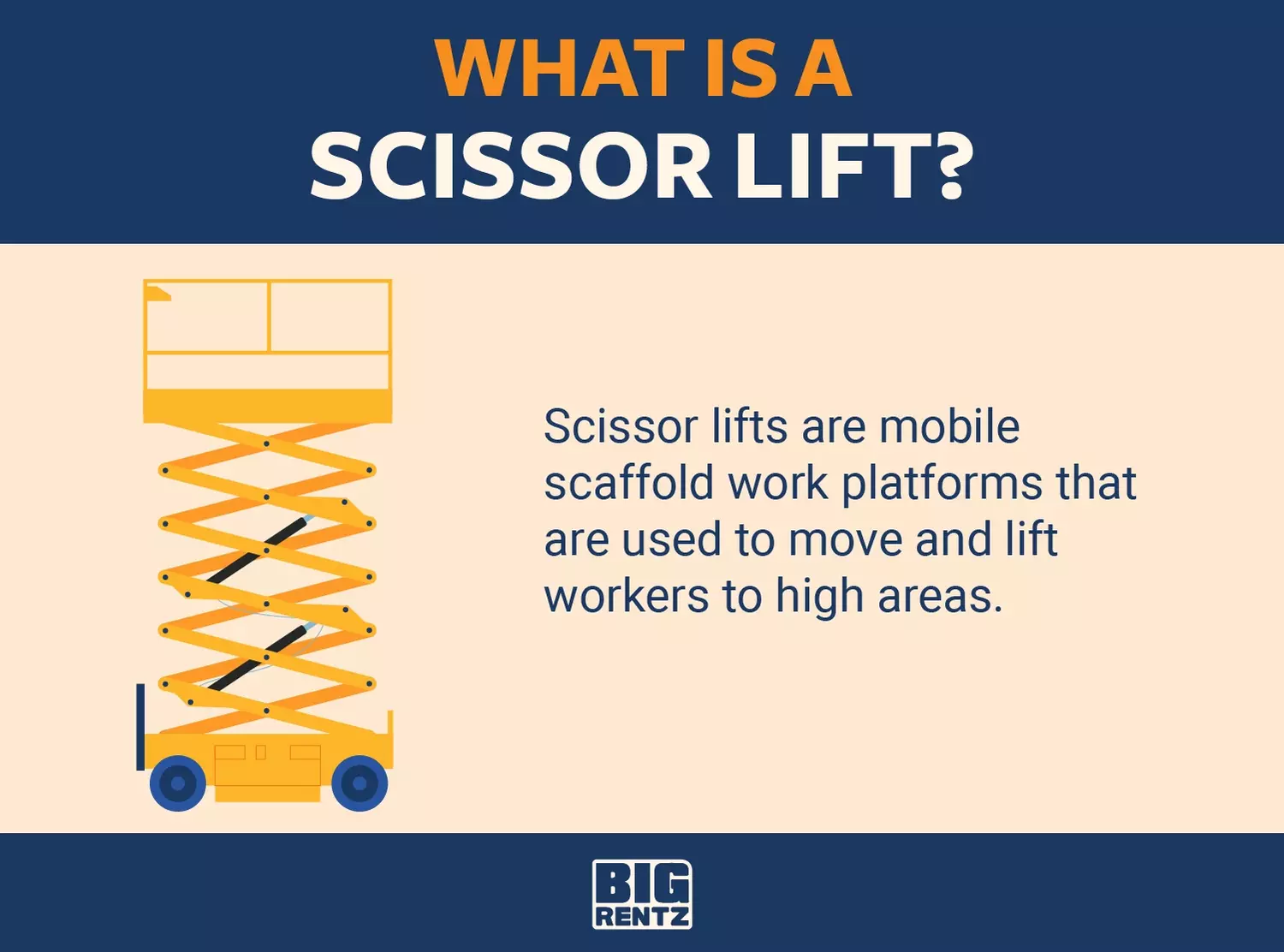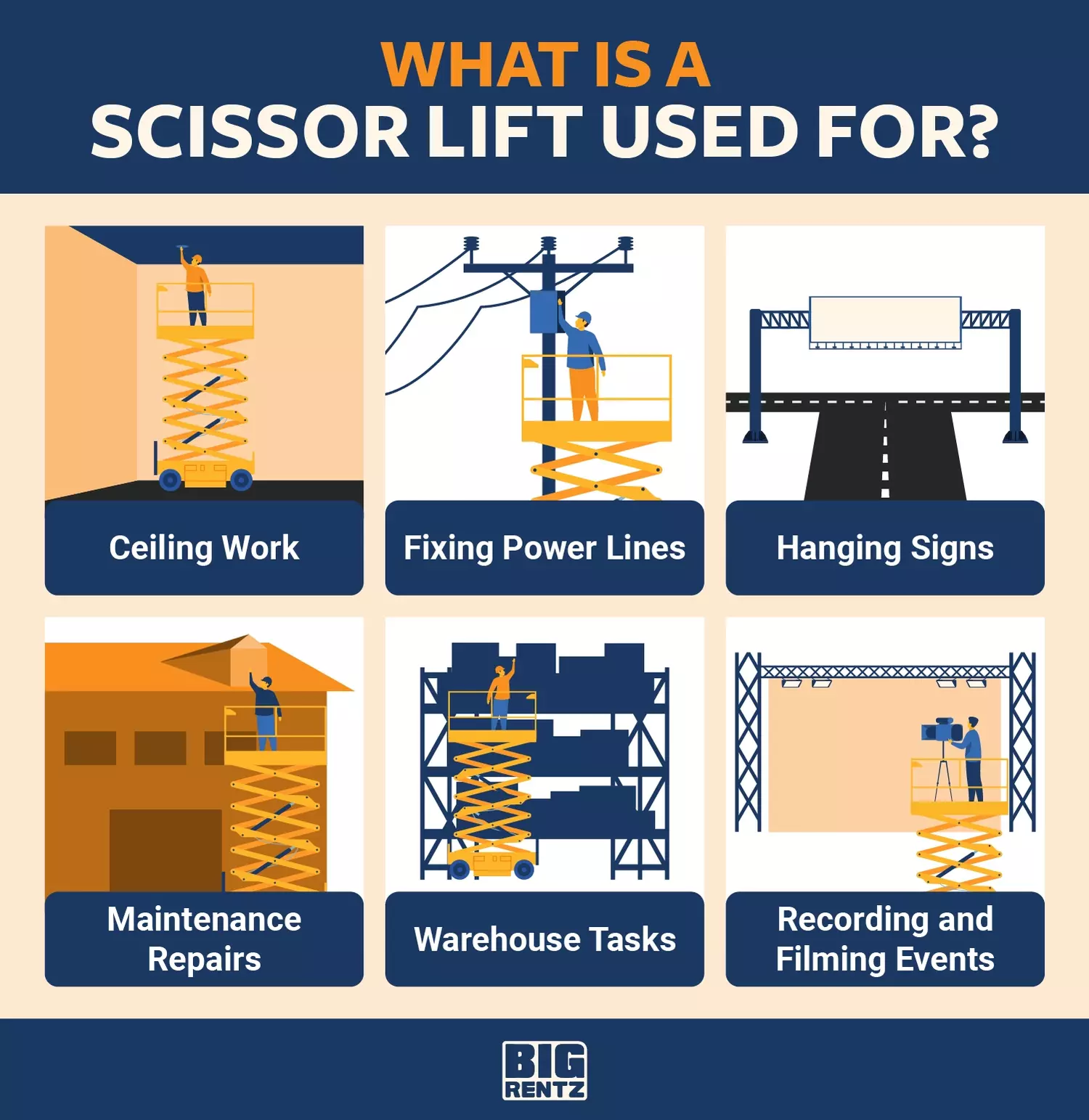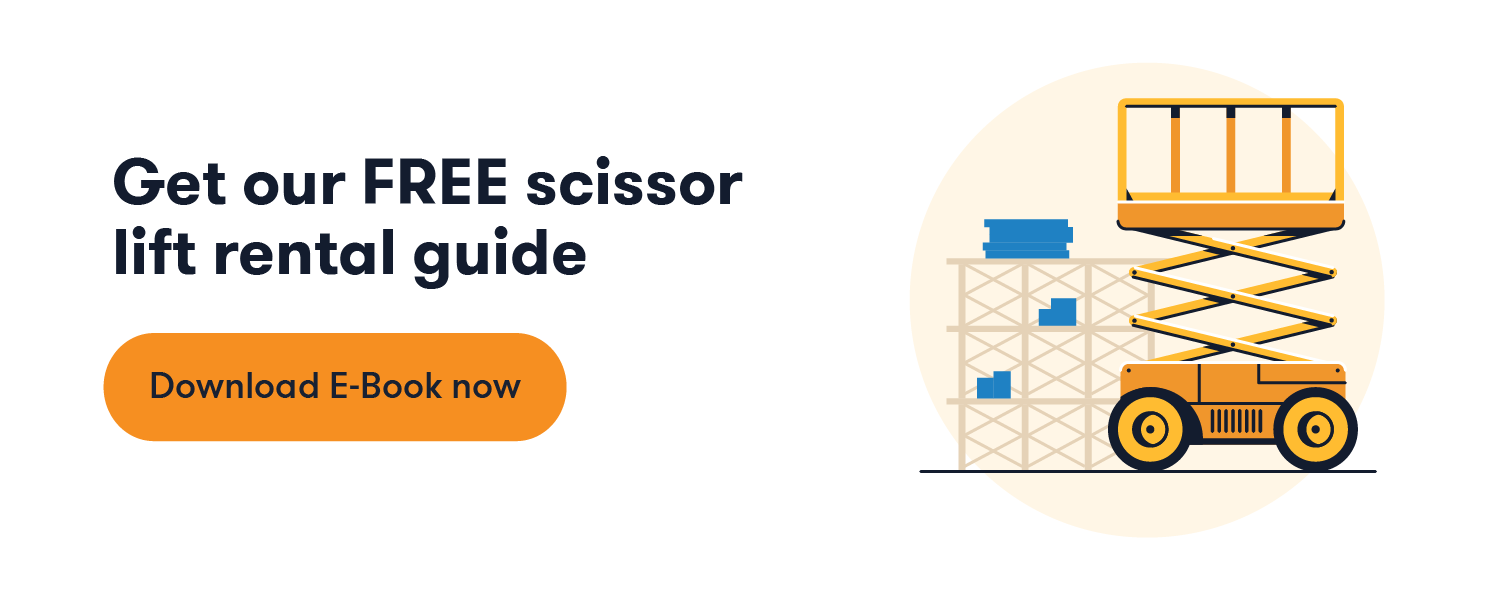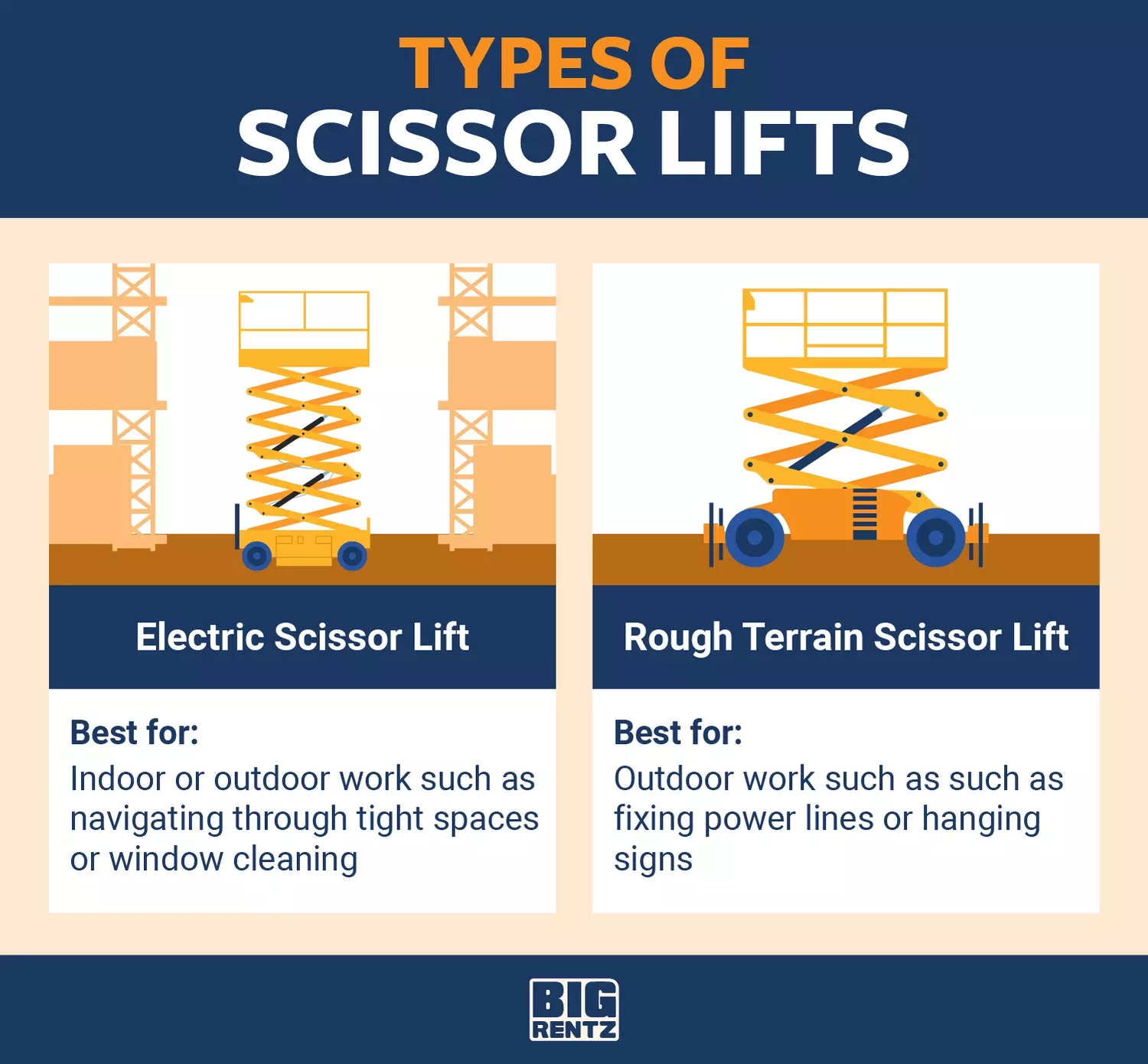A scissor lift is a mobile scaffold used to raise people and materials. The platform goes up and down using crisscrossed beams that move in a scissor-like way. Scissor lifts are classified by OSHA as mobile-supported scaffold work platforms rather than aerial lifts because the lifting mechanism moves only vertically.
Scissor lifts can help with any task that involves elevated workspaces, including sign hanging, ceiling work, light fixture installation, or maintenance tasks. They are also useful for outdoor projects such as bricklaying, tree trimming, or working on power lines.
This post discusses the ins and outs of scissor lifts, including applications for use, safety measures, and how best to choose one for your needs.
Explore All Scissor Lifts
Table of contents
- How High Can a Scissor Lift Go?
- What Is a Scissor Lift Used For?
- How to Choose a Scissor Lift
- Types of Scissor Lifts
- Scissor Lift vs. Boom Lift
- Do You Need Certification to Use a Scissor Lift?
- Scissor Lift Safety
- Need to Rent a Scissor Lift?

How High Can a Scissor Lift Go?
Scissor lifts come in different sizes that can commonly reach from 19 to 50 feet off the ground. Compact scissor lift models are lighter but can hold less, while bigger models have less maneuverability but a higher weight capacity. For example, a 50-foot scissor lift can lift up to 2,250 pounds.
What Is a Scissor Lift Used For?
A variety of work environments make use of elevated work platforms (EWP), from construction sites to indoor warehouses to film studios.

Ceiling Work
Schools, hospitals, hotels, factories, and other buildings with high ceilings often use scissor lifts for elevated tasks. Workers may use the elevated platforms to install or replace overhead lighting, cables, and HVAC pipes. They may also use scissor lifts for painting, constructing, or fixing damage on ceilings or high walls.
Fixing Power Lines
Because they have good stability and safety, scissor lifts often make a great choice for fixing and maintaining power lines. The elevating work platform raises workers and tools up to the power lines, where they can make repairs.
Hanging Signs
Scissor lifts can help workers hang indoor and outdoor signage. Construction worksites may use them to put up notices warning pedestrians of work ahead or businesses may use them for commercial purposes, such as hanging retail store signs.
Maintenance Repairs
Scissor lifts can help with any repair or maintenance task that requires an aerial work platform. Industrial workers may use them to check large machinery; HVAC technicians may use them to inspect pipes or A/C units; and maintenance workers may use them to repair ceiling damage.
Warehousing
Warehouses make use of scissor lifts for all kinds of tasks. Scissor lifts offer a safe way to streamline inventory processes, including loading and unloading pallets and lifting and retrieving heavy goods from shelves. Scissor lifts can also be used for other general tasks in the warehouse such as changing light fixtures and hanging signs.
Recording and Filming Events
Creative productions also make use of scissor lifts. For example, in the media or film industries scissor lifts can help photographers or videographers capture an event from a different angle. Artists may also use them when they need a boost for big projects like high murals or tall sculptures.
::backdrop{background:rgba(0,0,0,.65)}.cta–dialog[open]{border-width:0;display:flex;flex-direction:column;align-items:center;width:90%;max-width:37.5rem;padding:1.5rem}.cta–dialog[open] .dialog–close{position:absolute;top:1.25rem;right:1.5rem;font-size:30px;line-height:1}.cta–dialog[open] .dialog–header{font-size:1.5rem;font-weight:500;line-height:1.3;text-align:center;margin:1.5rem auto .5rem;padding:1.5rem 0 0}@media (min-width: 768px){.cta–dialog[open] .dialog–header{font-size:2rem;margin:0 0 .5rem;padding:0;text-align:left;width:80%}}.cta–dialog[open] .wrapper–form-illo{display:flex;flex-direction:column;align-items:center;width:100%}@media (min-width: 768px){.cta–dialog[open] .wrapper–form-illo{flex-direction:row;justify-content:center;column-gap:2rem}}.cta–dialog[open] svg{margin-top:.5rem;width:52%;max-width:11.5rem}@media (min-width: 768px){.cta–dialog[open] svg{margin-top:0;max-width:15rem}}@media (min-width: 768px){.cta–dialog[open]{align-items:flex-start}}

×
Download our FREE scissor lift rental guide e-book today!
How to Choose a Scissor Lift
The right scissor lift for your jobsite depends on a number of factors, including lift size (both platform height and lift capacity), type of work area you will be in, and what kind of task you will be performing. When choosing a scissor lift, consider the following:
- Working height: First, consider the height requirements of your job. With scissor lift heights typically ranging from 19 to 50 feet, you have a number of options to choose from.
- Platform width: Next, think about the platform size you will need. While platforms come in standard sizes, you can choose an extended platform. If your job requires larger platforms, make sure to adjust your calculations accordingly to keep the loads balanced.
- Type of environment: The environment and terrain of your jobsite will affect your choice of lift. If you’re working indoors, for example, you may need an electric-powered lift with no emissions and non-marking tires. If you need a scissor lift for outdoor use on rough ground, you may opt for a four-wheel-drive model.
- Load capacity: Another key consideration is lift capacity. You need to account for the goods, tools, and workers that the lift needs to accommodate. If you plan to carry multiple workers or heavy loads, you may want to look for a heavy-duty scissor lift.
- Type of work task: Finally, think about the type of task you need to perform. Ceiling work may require a higher lift platform while warehouse work might prioritize maneuverability over height.
Example Scissor Lift Specifications
To put these considerations into practice, take a look at the following comparisons between scissor lift options.
- 19-foot electric scissor lift: Because it produces no emissions, this lift is ideal for indoor environments. It can assist workers with tasks like sign hanging, ceiling work, and a variety of installation and repair jobs. The wide platform holds multiple occupants, making this model suitable for construction or maintenance crews.
- 26-foot electric scissor lift: Useful for both indoor and outdoor projects, this electric lift lends itself to tasks like ceiling repair, sign hanging, and tree trimming. While suitable for multiple occupants and a variety of construction and maintenance jobs, this model doesn’t make the best choice for tight spaces or going over obstacles.
- 26-foot rough-terrain scissor lift: Although it has the same lift height as the electric model, other factors make this option preferable for outdoor use. Its four-wheel-drive system allows scissor lift operators to maneuver sloped inclines and work off road if needed. While more expensive than the electric option, this heavy-duty lift has triple the load capacity and excels in extensive industrial and construction applications.
- 40-foot rough-terrain scissor lift 4WD: For outdoor jobsites on uneven terrain, this four-wheel-drive lift provides a stable base for workers. The interlocking support beams allow multiple occupants to use the platform and to safely complete tasks at high elevations. Suitable applications for this lift include outdoor maintenance, construction, and industrial projects.
Types of Scissor Lifts
Both electric and rough-terrain scissor lifts can lift multiple workers to elevated heights, but the similarities end there. Below we cover the differences between these two types of scissor lifts.

- Electric scissor lift: Quiet, maneuverable machines with zero emissions, electric scissor lifts excel in indoor environments with level surfaces. They lend themselves to projects like window cleaning, fixture installation, and building repairs.
- Rough-terrain scissor lift: Rough terrain scissor lifts make a great choice for outdoor industrial and construction applications. If your project involves uneven surfaces or off-road navigation, these four-wheel-drive models fit the bill.
Scissor Lift vs. Boom Lift
While scissor lifts and boom lifts both provide access to elevated work areas, the two machines move differently and serve different purposes. Boom lifts elevate workers in a small bucket or compact platform using a hydraulic lift system. Unlike scissor lifts, boom lifts can move both horizontally and vertically. Choosing between a scissor lift and a boom lift depends on the nature of your project and the limitations of your worksite.
table {
width:100%;
border:1px solid #b3adad;
border-collapse:collapse;
padding:5px;
}
table th {
border:1px solid #b3adad;
padding:5px;
background: #f88f1f;
color: #ffffff;
}
table td {
border:1px solid #b3adad;
text-align:left;
padding:5px;
background: #ffffff;
color: #313030;
}
| Scissor Lift | Boom Lift | |
|---|---|---|
| Reach height | Up to 50 feet | Up to 210 feet |
| Direction | Straight up-and-down | Rotates 360 degrees |
| Platform capacity | Can carry up to 2,250 Lbs | Can carry up to 500 Lbs |
| Terrain | Smooth, flat, or uneven surfaces | Uneven, rocky, or flat surfaces |
| Price (Monthly Rate) | $475–$3,000 | $1,675–$8,000+ |
- Reach height: Boom lifts can reach greater heights than scissor lifts. In fact, telescopic boom lifts may have a maximum reach height of more than four times that of a scissor lift.
- Direction: While scissor lifts can only go up and down, boom lifts can move both vertically and horizontally. Many boom lift bases can rotate workers 360 degrees, and articulating boom lifts have the added capacity to go around obstacles.
- Platform capacity: The superior mobility of boom lifts limits the amount of weight they can carry. While boom lifts can carry up to 500 pounds, some scissor lifts can hold over four times that amount at 2,250 pounds.
- Terrain: Diesel boom lifts equipped with rugged tires can navigate uneven, rutted, and rocky outdoor surfaces. Similarly, some scissor lifts also come with four-wheel-drive and diesel engines that allow them to work on rough terrain.
- Price: Boom lifts tend to cost more than scissor lifts. Depending on location, a 40-foot narrow frame scissor lift may cost you $601 per week, whereas a 40-foot telescopic boom lift may cost you $761 per week.
Do You Need Certification to Use a Scissor Lift?
Employers must provide training to workers on how to properly operate scissor lifts, but an official certification isn’t required. Under OSHA guidelines, employers must train employees on how to work safely with or near scissor lifts, how to handle materials on the lift, and what worksite hazards they might encounter while operating the lift.
Although stopping short of requiring certification, the agency stipulates that only employers should only permit trained personnel to use a scissor lift. This makes employers largely responsible for ensuring that workers operate lifts safely.
OSHA also provides a one-hour scissor lift training course online that covers key topics such as safety procedures, applicable OSHA standards, the importance of inspections, and precautions for preventing falls, tips, electrocution, and other common hazards.
Scissor Lift Safety
Although scissor lifts are considered relatively safe and stable machines, workers must always follow safe operating procedures to prevent accidents and injuries. The Occupational Safety and Health Administration (OSHA) and the American National Standards Institute (ANSI) have established the following key safety guidelines for scissor lift operation:
- Scissor lifts must have guardrails. To prevent falls, employees must check that a guardrail system is in place and in good condition prior to use. They must also make sure to stand only on the platform (and never on the guardrails) and avoid leaning too far over the platform.
- Scissor lifts must be stable before operating. Employees must stabilize scissor lifts by placing them on firm, level surfaces away from potential hazards. When using lifts outdoors, do so only in safe weather conditions with wind speeds lower than 28 miles per hour. Finally, workers should make sure to follow the manufacturer’s instructions for safe lift movement.
- Scissor lifts must be positioned correctly. Scissor lifts can pose electrocution and crushing hazards if positioned improperly. Select work locations at least 10 feet away from power sources and without any overhead hazards (like branches and door frames).
Pay attention when positioning or operating a scissor lift near other workplace hazards like fixed objects or moving machines. Make sure to take traffic control measures to prevent other vehicles or people from getting too close to a moving lift.
Need to Rent a Scissor Lift?
If your project calls for an elevated work platform, we have a variety of scissor lift rentals to fit your needs. Ranging from 19 feet to 50 feet, our scissor lifts come in narrow, wide, indoor, outdoor, electric, and diesel options to meet your needs. Whether you’re looking for an emissions-free indoor lift or need a heavy-duty model that can handle rough terrain, we have the scissor lift to help you get the job done.
Explore All Scissor Lifts